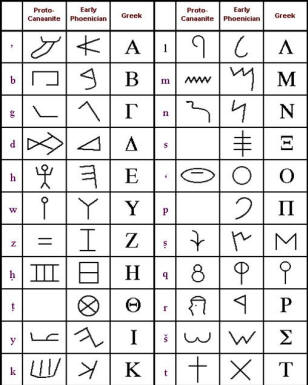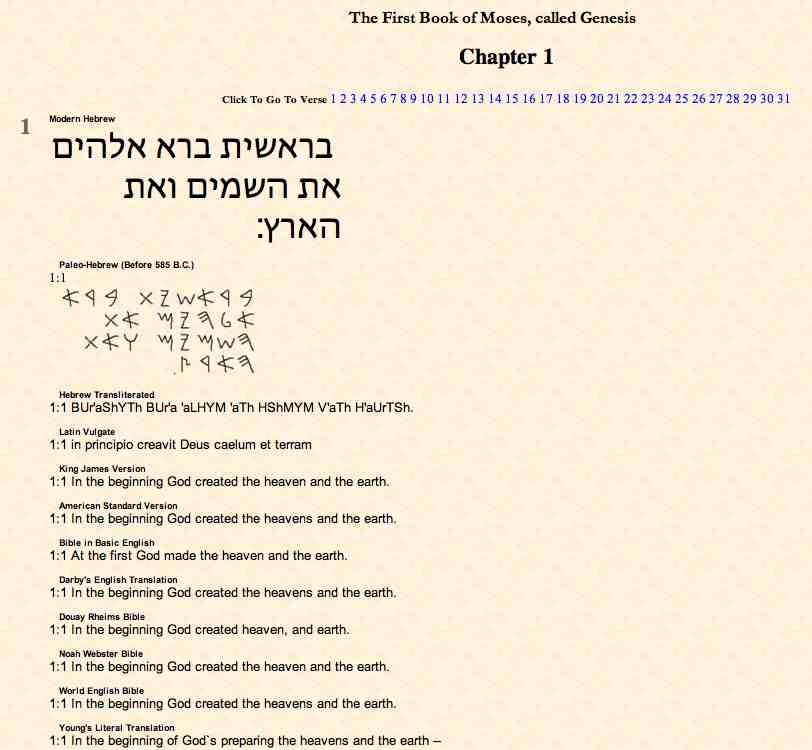Hmm, you might wonder: did Moses really write His first Torah in this picture-letters form? If yes, I would like to see it, how does it look! If yes, please click on “Paleo-Hebrew TORAH” and you can see it with your own eyes. 😉 To be sure to have the Paleo-Hebrew fonts, please use FIREFOX or EXPLORER browser. Chrome or Safari doesn’t show it properly.
Here is another place where you can see the whole Old Testament in Paleo-Hebrew parallel including other translations: Parallel Hebrew Old Testament Index
And if you wish to have it in your own computer, you might want to download it here (right-click on the title and click on “Save link as…”): TORAH.
Just please be aware that different fonts of the Paleo-Hebrew are used.

Today (March 6, 2016) I have found a new web with the TORAH in Paleo-Hebrew in one page and you can search the text!!! It is absolutely amazing for those who love Paleo-Hebrew 😉



This is very interesting. Does this mean that I have to go back to the Paleo Hebrew of the Tanach to get the true meaning of the word in the Tanach? I have found that it is necessary to go back to the original Hebrew that the Tanach (Old Testament).; Does this article mean that I have to go back to the Paleo Hebrew script to get the true meaning of the Tanach?
Hi Albert,
If you are able to check things out in the Hebrew you are already way ahead of common people and for sure this should be sufficient for deeper understanding of God’s Word. On the other hand, if you have time and desire to get additional insights through Paleo-Hebrew, please do so. It will enrich your life and should make you love our Creator and Saviour even more. If it should serve us to boast that we know something more than others then we are obviously “missing the boat.”
Let me give you illustration:
In Ex 20:8 we read in English: Remember the sabbath day, to keep it holy.
In Hebrew we gain extra insight: זכור את יום השבת לקדשו
Do you see it? English is missing the key word את – Aleph-Tav, people know this name rather in Greek as Alpha and Omega. Everyone knows that this is the name Jesus Himself uses for Himself, like in Rev 1:8 “I AM ALEPH-TAV”
When you go here you can see this text in Paleo-Hebrew and the Aleph-Tav in pictures shows you the OX and CROSS. Some read these two pictures as “Plow towards the Mark” someone else as “Strength of the Covenant“. I read it as “Self-denying Servant” or “Living Sacrifice“. I love Jesus under this name very much!
To sum it up: What make Sabbath day different than other days is the presence of Jesus in it – His Spirit of willing service to the point of self-denial. When people reach such state of mind, such attitude, you can feel like in “heaven on earth.” Am I right? 😉
I love how other passages of Scriptures actually bring up on surface this missing part in English translation, where Aleph-Tav is missing:
And He said unto them, The Sabbath was made for man, and not man for the Sabbath. Therefore the Son of man is Lord also of the Sabbath. Mark 2:27-27
Aleph means also Leader, the Almighty. And we have to be careful not to abuse Jesus grace and switch faith into presumption, which is Satan’s substitute of trusting faith. In Numbers 15:32-36 we find a story who was picking sticks during the Sabbath day and Jesus commanded him to be stoned! Same God exerts grace over ignorant people, yet expects greater reverence from those who know Him and to whom He revealed already so much of His love. So there is a balance:
Behold therefore the goodness and severity of God: on them which fell, severity; but toward thee, goodness, if thou continue in his goodness: otherwise thou also shalt be cut off. Rom 11:22
Can you tell me what Torah means in paleo?